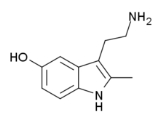
2-Methyl-5-hydroxytryptamine
Encyclopedia
2-Methyl-5-hydroxytryptamine (2-Methylserotonin, 2-Methyl-5-HT) is a tryptamine
derivative closely related to the neurotransmitter
serotonin
which acts as a moderately selective
full agonist at the 5-HT3 receptor.
Tryptamine
Tryptamine is a monoamine alkaloid found in plants, fungi, and animals. It is based around the indole ring structure, and is chemically related to the amino acid tryptophan, from which its name is derived...
derivative closely related to the neurotransmitter
Neurotransmitter
Neurotransmitters are endogenous chemicals that transmit signals from a neuron to a target cell across a synapse. Neurotransmitters are packaged into synaptic vesicles clustered beneath the membrane on the presynaptic side of a synapse, and are released into the synaptic cleft, where they bind to...
serotonin
Serotonin
Serotonin or 5-hydroxytryptamine is a monoamine neurotransmitter. Biochemically derived from tryptophan, serotonin is primarily found in the gastrointestinal tract, platelets, and in the central nervous system of animals including humans...
which acts as a moderately selective
Functional Selectivity
Functional selectivity is the ligand-dependent selectivity for certain signal transduction pathways in one and the same receptor. This can be present when a receptor has several possible signal transduction pathways...
full agonist at the 5-HT3 receptor.
See also
- 5-Carboxamidotryptamine5-Carboxamidotryptamine5-Carboxamidotryptamine is a tryptamine derivative closely related to the neurotransmitter serotonin.5-CT acts as a non-selective, high-affinity full agonist at the 5-HT1A, 5-HT1B, 5-HT1D, 5-HT5A, and 5-HT7 receptors, as well as at the 5-HT2, 5-HT3, 5-HT6 receptors with lower affinity. It has...
- 5-Methoxytryptamine5-Methoxytryptamine5-Methoxytryptamine , also known as mexamine, is a tryptamine derivative closely related to the neurotransmitters serotonin and melatonin. 5-MT has been shown to occur naturally in the body in low levels. It is biosynthesized via the deacetylation of melatonin in the pineal gland.5-MT acts as a...
- α-Methyl-5-hydroxytryptamine

